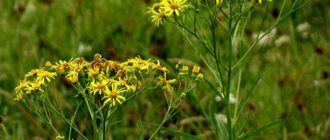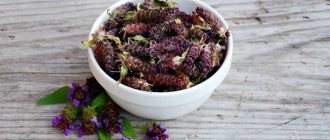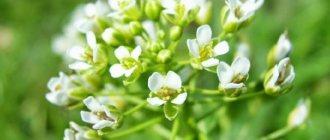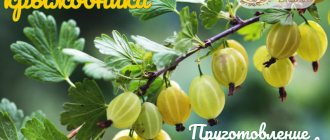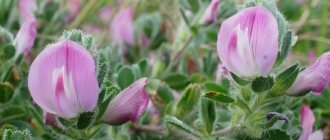What does winterweed look like and where does it grow?
Wintergreen is a perennial wild plant of the Heather family, which has a lot of useful properties. It is distinguished by its frost resistance and external resemblance to lingonberries. The winter-loving plant is popularly called the core and spool. The plant has strong creeping roots that allow it to stay on the surface even at low temperatures.
Wintergreen branches at the base. The shoots and stems of the plant are quite strong. Petiolate sessile leaves are small in size. Their width is 2 cm and length is 12 cm. The leaf blade has pointed edges and a leathery surface. Pedicels at the base of the leaves appear in early summer. In length they can exceed the leaf part. The inflorescences resemble the shape of a chamomile. They are distinguished by pinkish petals. 2-8 inflorescences can form on one peduncle. Winter-loving fruiting begins at the end of summer. A small flattened box appears on it, inside which there are black or brown seeds. Its surface is covered with small fibers.
The winter-lover prefers areas with a temperate climate. She feels good in shady coniferous forests. Clay soils and sandstones are considered good environments for plant growth. In Russia, wintergreen is found in the Far East and Siberia. Some species live in Korea, China and Japan. Photo of the winter-loving plant:
During the entire flowering period, it is recommended to cut the leaves of the plant no more than 3 times.
Comment! In some regions, the winter-loving plant is listed in the Red Book.
Chemical composition of wintergreen
Wintergreen was used for medicinal purposes due to its unique composition and valuable properties. The composition is represented by vitamins, acids and organic compounds. In ancient times, the plant was even credited with magical properties. Today, the content of useful substances allows it to be used in the fight against serious diseases. The chemical composition of wintergreen includes the following elements:
- glycosides;
- flavonoids;
- methyl esters;
- organic compounds;
- tannins;
- vitamins A and C;
- resins and mucus;
- triterpenoids;
- phenols;
- bitterness.
The vitamin component of wintergreen ensures strengthening of the immune system and overall health of the body. The presence of glycosides in the composition makes the plant a valuable tool in the treatment of cardiovascular diseases. In addition, they provide relief from swelling. Tannins are beneficial for the digestive tract, and triterpenoids help cope with inflammatory and infectious diseases.
Properties of wintergreen - harm and benefit
Medicinal properties
The chemical composition of the umbrella plant includes microelements that affect the functioning of human organs and the state of the accompanying microflora, both harmful and beneficial: arbutin, ericolin, glycosides, tannins, bitterness, resins, ursolic and salicylic acids, methyl esters, quercetin, hyperin , avicularin, kaempferon. These are just the main active ingredients of wintergreen. It is the chemical composition that determines the antiseptic, anti-inflammatory, analgesic, diuretic and expectorant properties of the plant.
- Conditions for growing ranunculus on a windowsill
Wintergreen herb helps remove nitrogen and chloride salts from the body and normalizes digestion. Prescribing winterweed for diabetes mellitus is justified, since it lowers blood sugar levels. Wintergreen is indicated for chronic inflammation of the genitourinary system, prostate diseases, nephritis, chronic and acute cystitis, difficulty urinating and even gonorrhea.
In folk medicine, wintergreen is used to treat prostatitis, inflammatory processes of the digestive organs, dropsy, diabetes, shortness of breath, intestinal tuberculosis, rheumatism, gout, edema, hernia, menstrual irregularities, disruptions in the functioning of the heart and kidneys. For oncological diseases, wintergreen is prescribed in addition to traditional methods of treatment. Wintergreen is used to treat diarrhea, and it is used externally to heal burns, wounds and relieve inflammation in the eye area, mammary glands and lips.
Wintergreen tincture, as well as decoction, tea and infusion are used as medicinal preparations. For example, wintergreen for weight loss is used in the form of a tincture, but even in this matter you must strictly follow the doctor’s prescriptions and instructions.
Wintergreen decoction: pour a tablespoon of dried wintergreen herb into two glasses of boiling water, cook, stirring, over low heat for 10-15 minutes, then let it brew for three hours, strain and store in a thermos for no longer than two days. Use for inflammatory processes of internal organs and bleeding, 2 tablespoons before meals, for swelling - half a glass in the morning on an empty stomach, for digestive diseases - a third of a glass three times a day.
Wintergreen - contraindications
Like almost any medicinal plant, wintergreen has its own contraindications. For example, it is undesirable to use it for people whose bodies are prone to blood clots. Contraindications are pregnancy, breastfeeding, hypertension, excessive excitability, chronic constipation and individual intolerance to the product.
Medicinal properties of wintergreen herb
The plant has a lot of useful properties that make it suitable for use in alternative medicine. That is why it can be found in some herbal preparations. The main feature of the plant is its diuretic and pronounced tonic properties. Wintergreen is often used to treat kidney and gynecological diseases. Its tonic property allows it to be used for recovery after physical exhaustion or serious illnesses.
The most pronounced medicinal effects of winterweed include:
- antibacterial effect;
- decreased blood glucose levels;
- restoration of hormonal levels;
- normalization of digestion;
- antiparasitic effect;
- relieving nervous tension;
- increased performance;
- diuretic effect;
- strengthening the immune system;
- acceleration of regenerative processes;
- elimination of swelling.
Wintergreen can be found in teas intended for general health. It cleanses the body of potentially dangerous substances and stimulates the immune system. This allows it to be used to protect against possible diseases and aggressive environmental influences.
Zolotnik is considered an excellent honey plant
The healing properties of wintergreen for women
Wintergreen is widely used in gynecology. It is often used to treat genitourinary infections and hormonal disorders. Antibacterial and anti-inflammatory properties allow the plant to be used in cases of kidney dysfunction. When used in therapeutic dosages, wintergreen prevents cancer. As part of combination therapy, it has the following indications:
- benign cystic formations;
- erosion;
- adnexitis;
- menstrual irregularities;
- uterine bleeding.
The healing properties of winterweed for men
Zolotnik is often added to herbal preparations intended for men. It supports reproductive function and helps eliminate infectious diseases. It can be used as a prophylactic against impotence. The substances that make up the plant stabilize the process of hormone production, thereby increasing sexual desire. Experts recommend using winterweed for men involved in sports and heavy physical labor.
Why winterweed is useful for children
Since wintergreen is considered a potential allergen, it should not be used by children under 12 years of age. In older age, the possibility of use is discussed with the pediatrician. Indications for using the plant for medicinal purposes:
- immunodeficiency;
- postoperative period;
- stomatitis;
- streptococcal and staphylococcal skin diseases;
- cystitis.
History of discovery
You may be interested in:
Thyme: medicinal properties, scope of application, for what diseases it is used Thyme is not only an aromatic spice, but also a medicinal herb, which is a panacea for a large amount of...Read more...
The history of the use of wintergreen as a medicine begins in the 18th century. It was then that the first European conquerors of North America noticed that Indian tribes treated this inconspicuous plant with special reverence, considering it a real gift from the gods.
Later it was discovered that such veneration had a completely rational basis, because the winter-lover saved the local aborigines from many different diseases. With the help of its fresh leaves, bleeding was stopped and burns were healed, and eyes, joints and spine were treated with infusions and decoctions.
The ancient Indians owned many secret recipes, which were based on wintergreen. The plant was believed to have not only healing, but also magical properties, so it was also used in a large number of witchcraft and love potions. True, unlike the modern name, the Indian name of the grass had a completely different meaning. In the Mohican language it sounded like pipsisikweu or “crushing into small pieces.”
This definition was not given by chance, because the indigenous people of America believed that pipsisikweu somehow magically helps to crush and remove kidney stones. As it turned out later, there is a completely scientific explanation for this belief - the leaves of the plant contain a special substance that actually dissolves small kidney stones.
You may be interested in:
Tomatoes under the snow with garlic This recipe got its name “tomatoes under the snow” because it is prepared with garlic, which is in a jar...Read more...
The conquerors of North America gradually mastered the secret knowledge of the indigenous Indians, and then spread it throughout Europe. Despite all the evidence of the effectiveness of wintergreen herb, its use in Russia has never become official. Nevertheless, healers in Siberia and Altai today actively use this plant to heal their patients from many serious diseases.
The use of wintergreen herb in folk medicine
In alternative medicine, the plant is used in several variations. Vitamin teas, infusions, decoctions, and tinctures are prepared from it. The juice of the plant is no less popular. Each form of the drug has certain manufacturing nuances and a dosage regimen. In some cases, it is possible to combine several methods of application at once.
Advice! For diseases of the female reproductive system, a medicinal decoction from the plant can be used for douching.
Infusions
An aqueous infusion of wintergreen is considered the easiest form of medicine to prepare. Its disadvantages include a short shelf life. Therefore, it is necessary to prepare the infusion in small portions.
Components:
- 500 ml hot water;
- 2 tbsp. l. dried herb.
Cooking process:
- The wintergreen is placed in a clean container and filled with hot water.
- The drink is infused for 1 hour.
- After the specified time, the liquid is filtered and then taken orally.
The drink cannot be infused for longer than 1 hour, otherwise it will turn out too strong
Decoctions
Ingredients:
- 400 ml water;
- 2 tbsp. l. dry raw materials.
Recipe:
- Dried wintergreen leaves and inflorescences are placed in a small container and filled with water.
- The medicinal product is brought to readiness in a water bath within 15 minutes after boiling.
- The finished drink is filtered and stored in the refrigerator. In this form, it must be used within 3 days.
Ready-made spool can be purchased at a specialty store or pharmacy
Tinctures
The alcohol tincture has a high concentration of active substances. Therefore, it is customary to use it in small dosages. It has a powerful immunostimulating and antioxidant effect. However, due to the alcohol content, the remedy has a lot of contraindications. It is prohibited to use for kidney and liver diseases.
Components:
- 100 ml alcohol;
- 1 tbsp. l. dried inflorescences.
Cooking steps:
- The plant is poured into a dark glass container and filled with alcohol.
- The duration of infusion of the drink in a dark place is 2 weeks.
- If necessary, filter the tincture before use. It should be stored in the refrigerator without violating the shelf life of 2 years.
The local method of using medicinal tincture is relevant for rheumatism and gout
Tea
Components:
- 250 ml boiling water;
- 1 tsp. dried wintergreen.
We recommend reading: Mint tea: beneficial properties and contraindications, how to make
Recipe:
- The plant is poured into a cup and filled with hot water.
- The tea is steeped for no more than 10 minutes without covering the cup with a lid.
- To reduce the concentration of active components, tea can be diluted with clean water.
To make tea, spool can be mixed with other medicinal plants
We recommend reading: Tea with thyme: beneficial properties and contraindications
Juice
Wintergreen juice is obtained from a fresh plant. To do this, it is twisted together with the inflorescences through a meat grinder or blender. The resulting plant slurry is then separated from the liquid. It is customary to drink the resulting juice from the plant in case of food poisoning, 1 tsp, after diluting it with a small amount of water.
Important! To increase the nutritional value, it is recommended to add honey or lemon to the wintergreen drink.
Before preparing the juice, the leaves of the plant are thoroughly cleaned of dirt and dust.
Recipes with wintergreen
Below are recipes for preparing products based on wintergreen.
Alcohol tincture of common winterweed
Tincture
You can buy a ready-made tincture at a pharmacy or prepare it yourself at home.
Ingredients:
- wintergreen (raw material) - 50 g;
- vodka - 250 ml.
How to prepare: Pour the raw materials into a jar, fill with vodka, close the lid and put in a dark room for 2 weeks. Strain.
How to take: Drink 0.5-1 tsp. tinctures 3-4 times a day an hour before meals. In this case, the maximum single dosage is 1 tsp. prohibited from exceeding.
Result: You need to take the tincture for 2-3 months, after which you will need a break for the same period. In one weight loss course you can lose up to 5-6 kg. The tincture should be stored in the refrigerator for 3-4 days, after which a new drink should be prepared.
Infusion for obesity
Ingredients:
- water - 1 l;
- Winter grass - 4 tbsp.
How to prepare: Pour boiling water over the raw material, cover with a lid and leave for 10-12 hours. Strain.
How to take: Drink 1 tbsp. means 20-30 minutes before meals no more than 4 times a day.
Decoction
This drink with winter-loving umbrella is prepared from dry raw materials sold in pharmacies. Each portion is prepared only for 1 day; the next day you need to make a fresh decoction.
Ingredients:
- water - 1 glass;
- wintergreen - 1 tbsp.
How to cook: Pour the raw materials into a saucepan, pour boiling water, then place on the stove and bring to a boil. After this, simmer the mixture over low heat for another 10 minutes. Cool and strain.
How to use: Take 1 tbsp decoction. 3-4 times a day half an hour before meals.
Result: This drink has a tonic effect on the body, removes excess fluid, and improves digestion processes.
Tea
Ingredients:
- water - 1 glass;
- wintergreen raw material - 1 tbsp.
How to prepare: Pour boiling water over the herb, leave for 20-30 minutes.
How to use: Drink tea in small sips throughout the day.
Result: This drink has a tonic effect.
The use of wintergreen in cosmetology
Wintergreen is no less widespread in cosmetology. It copes well with acne and the first changes of age. An infusion prepared from it is frozen and then used to wipe the skin. This procedure allows you to keep it in good shape and refresh your complexion.
Alcohol tincture of wintergreen is used as a cleanser. They wipe the skin of the face with it 2 times a day. This helps get rid of acne and clear pores. Before carrying out cleansing activities, it is advisable to thoroughly steam the skin.
Wintergreen decoction can be used to make homemade masks. It is mixed with carrier oils, clay and herbal extracts. The composition of the mask is determined by your skin type. The medicinal composition also has a positive effect on the condition of the hair. It is used to rinse hair after washing. This makes hair more manageable, shiny and smooth. Therapeutic compresses using a herbal decoction help get rid of dark circles under the eyes.
Brief description of the herb, growth, collection and storage rules
Wintergreen in the pharmacy
The collection of raw materials occurs three times during one summer. It is advisable to do this at the end of June, July and last time - in August. Only dry weather is suitable for this procedure, since under the influence of moisture the raw materials can lose all their medicinal properties.
Read more: Raw, boiled, baked and pickled beets: benefits and harm to the health of the human body. Medicinal properties of beets for women, men and children
After harvesting, it is necessary to thoroughly clean all dirt and soil from the stem and leaves. The workpiece must be dried in a dry and well-ventilated place, spread out on a baking sheet or other flat surface in one layer.
If you want to dry it in a special dryer, then set the temperature to 50°C. When the raw material is ready, it will become brittle and brittle. After this, you can collect the dried parts and place them in containers.
Contraindications
Despite the large number of medicinal properties, wintergreen grass also has contraindications.
These include:
- thrombosis;
- haemorrhoids;
- sleep dysfunction;
- pregnancy and lactation;
- hypertension;
- constipation;
- thrombophlebitis.
When the medication is used correctly, the likelihood of developing side effects tends to zero. Their appearance is possible in case of violation of the dosage and dosage regimen. In rare cases, an allergic reaction occurs due to intolerance to the plant. Its characteristic feature is skin rashes. The most common side symptoms include:
- physical weakness;
- nausea;
- decreased appetite;
- dizziness;
- migraine.
Collection and preparation of grass
The medicinal plant is collected during its flowering period. This happens in the second half of summer. Mainly the above-ground part of the plant is harvested. It is advisable to leave part of the bush so that over time it can recover on its own.
To preserve the medicinal properties of the plant for a long time, the collected stems, leaves and inflorescences are dried. The raw materials are carefully laid out on a flat surface in a ventilated area. It is important to avoid direct sunlight. The recommended drying temperature for the plant is 40-50 °C. The readiness of the raw material is indicated by a change in its structure.
When dried, the plant is stored for 2-3 years, using glass jars or paper bags as containers. For convenience, it is recommended to grind it until smooth. The safety of raw materials ensures compliance with temperature conditions and the absence of exposure to moisture.
Attention! To avoid insomnia, wintergreen decoction should be used no later than 3 hours before going to bed.
Brief description of the herb, growth, collection and storage rules
Wintergreen is a perennial that does not shed its leaves even in winter. The grass has a low stem on which there are leathery hard leaves and a powerful rhizome.
The flowers are large, pink or white, collected in large umbrella inflorescences. Flowering occurs in the summer months and ends with the formation of a small fruit-box.
The grass grows mainly in forests and groves, preferring cold or temperate zones of the Northern Hemisphere. It is successfully cultivated in warm regions - the plant is often grown in gardens, near outbuildings.
It is recommended to collect valuable plant materials three times a year. Starting in June, cut off the entire above-ground part every month and send it to dry.
It is advisable to dry in a dry room or under shelters. A prerequisite is good ventilation. Recommended temperature is 40-50 degrees. You can use an oven or a special dryer.
It’s easy to check the readiness of the raw materials - squeeze a few leaves with your hand. If they begin to crumble, send them for storage in a dry room, having previously packaged them in glass containers or cardboard boxes. The healing properties last a long time - at least three years.
Wintergreen in the pharmacy
If it is not possible to independently stock up on valuable raw materials, you can purchase wintergreen tincture at a pharmacy. The cost of a 100 ml bottle is 250-270 rubles. The drug is recommended for use for a number of diseases, including:
- hernia;
- heavy uterine bleeding;
- swelling caused by heart and kidney diseases;
- inflammation of the female organs;
- urinary incontinence;
- cough;
- diseases of the digestive organs;
- liver dysfunction;
- inflammation of joints, bone tissue.
It is recommended to take the medicine three times a day. Dosage – 35-45 drops, dissolve in 100 ml of water. The most effective would be to take before a meal - the active ingredients work most effectively on an empty stomach.
The drug has a number of prohibitions. If you are pregnant, have a tendency to form blood clots, or have frequent constipation, you will have to stop using the tincture. Individual intolerance is another contraindication to the use of the drug.
- Men who have been diagnosed with prostatitis by a doctor are recommended to use an alcoholic infusion of wintergreen to get rid of the unpleasant disease.
- A remedy prepared at home will relieve inflammation and pain, increase sexual performance, and reduce the activity of additional symptoms. Step-by-step folk recipe:
- Send the plant material (25 grams) crushed into fine crumbs into a glass bottle.
- Pour vodka (homemade first drink), you will need 400 ml of alcohol-containing liquid.
- Leave to infuse, capping the bottle tightly.
- Strain after three weeks, pour the liquid into a clean container.
Take the product twice a day. Dosage – 15 ml. If the use of alcohol-containing drugs is prohibited, dilute the homemade medicine with water (1-2 tablespoons).
- For cystitis, a rich decoction of wintergreen is an effective remedy that will help relieve inflammation, pain when urinating, and an unpleasant burning sensation in the perineum.
- Traditional medicine also suggests using home remedies for preventive purposes - in case of chronic cystitis, this precaution will prevent relapses. Preparation:
- Finely chop 15 gr. fresh grass leaves.
- Boil water (150 ml), steam the herbal mixture, stir.
- Leave for a quarter of an hour, strain.
Take the prepared product at one time. Use the decoction twice - in the evening and in the morning. The duration of treatment is a week, if the symptoms of the disease disappeared earlier, drink the entire course, this will reduce the risk of re-development of cystitis.
Intestinal dysfunction, frequent indigestion, and disorders are a reason to seek the help of a winter lover. The herb normalizes the functioning of the organ, activates the digestive processes, and relieves discomfort and pain. Step by step recipe:
- Chop dry grass (15 grams) and place in a saucepan.
- Pour boiling water (230 ml).
- Place on the stove and simmer for 5 minutes at a low simmer.
- Remove and leave until cool.
- After straining, begin treatment.
After each meal, consume 25 ml of decoction. The beneficial properties of homemade medicine are stored for no more than two days; after this time, prepare a fresh remedy.
A decoction of wintergreen, goat's rue, and mulberry bark will help normalize sugar levels. The drug can be taken at any stage of the disease, combined with drug therapy - the composition is completely safe and does not cause side effects. Step by step recipe:
- Mix goat's rue, wintergreen, mulberry bark (take the components in equal parts, 15 grams each).
- Pour in cool water (500 ml) and leave for an hour.
- Send to high heat, after boiling, simmer at low simmer for a quarter of an hour.
- After straining, bring to the original volume with boiled water.
Take the prepared medicine three times a day, 100 ml. The duration of the course is one month. Take a break and continue taking it after three weeks.
A concentrated herbal decoction is an effective medicine against the destructive tendency to alcohol. Regular use of the composition reduces cravings for alcohol, starts the process of regeneration of tissues damaged by alcohol, and causes aversion even to low-alcohol drinks. Step by step recipe:
- Chop 100 gr. fresh grass leaves, rub a little with your hands, after releasing the juice, leave for half an hour.
- Steam the green mass with boiling water (600 ml), leave for an hour.
- Place on the stove, boil, remove, cool under the lid.
- Carry out filtration, squeeze out the cake thoroughly.
Read more: Medlar fruit - benefits and harm to the body
Drink liquid three times a day, dosage - 100 ml. It is forbidden to add any components that can improve the taste - sugar, bee honey will reduce the effectiveness of traditional treatment.
Cyst treatment
A cyst is a disease that can be cured in advanced forms only by surgical intervention.
If you start treatment in a timely manner, you will be able to cope with the pathology using gentle methods - the use of folk remedies, among which herbal decoction is considered the most effective. Preparation:
- Combine wintergreen, cinquefoil, yarrow (15 g each).
- Pour boiling water over the herbal mixture; you will need 300 ml of water.
- Leave in a steam bath for 15 minutes, remove, wait until the liquid cools, strain.
Take 50 ml five times a day. Continue the course of treatment for half a month, pause (10 days), repeat.
Removal of parasites
Worm infestation is one of the diseases that frost-resistant perennials can cope with. It is recommended to combine it with tansy - this plant also effectively fights parasites that have occupied the human body.
The only caution is to use home medicine only for adults; it is better to give less aggressive formulations to children.
Mix 20 grams of herbal ingredients. Brew with boiling water (180 ml), leave until cooled, to increase the concentration of active elements, tightly close the container and wrap with a scarf. Filter and drink immediately in one go.
Take the decoction for three days, repeat after a week. Usually two courses are enough to completely get rid of parasites.
It is also recommended to use herbal medicine for preventive purposes - one course every 3 months is enough to protect the body from helminths.
Women who are unsuccessfully trying to cope with excess kilograms will benefit greatly from herbal remedies. Plant components effectively affect the functioning of the digestive system, activate metabolic processes, and burn fat deposits.
It should be remembered that at the same time as using the herbal remedy, you need to adjust your diet and increase activity, otherwise the extra pounds will be burned slowly. Preparation:
- Prepare herbal mixture - mix 10 grams. wintergreen, anise seeds, yarrow, rhubarb roots.
- Steam the plant mass with boiling water (400 ml).
- Place in a steam bath and simmer covered for 10 minutes.
After straining, divide the liquid into three parts. Drink throughout the day, observing equal time intervals. Weight loss should be carried out in courses - half a month of taking a herbal remedy, a week off.
The perennial has very few prohibitions, but it is better to familiarize yourself with the contraindications before use - this will help prevent complications and deterioration of health. The plant will cause harm to pregnant women, women breastfeeding their babies, and hypertensive patients (the herb can increase blood pressure).
Chronic constipation, blood disorders that can cause blood clots, hypersensitivity are a number of other prohibitions on the use of herbal medicines. Children are allowed to give decoctions based on the plant from the age of 12.
Improper use of the herb, individual intolerance, and errors in preparation can result in unpleasant complications.
Side effects include disorders of the digestive system (diarrhea, constipation), skin rashes, dizziness, and prolonged headaches. Alarm signals from the body should be a reason to immediately refuse to continue alternative treatment.
Wintergreen is a plant that hides many secrets. Fearless herb, which is not afraid of even severe frosts, is able to cope with serious pathologies of the body and protect against the development of a number of diseases.
Despite the mild, gentle effect on the body, it is better not to use the plant without prior approval from a specialist - self-medication can lead to unpleasant results and deterioration of health.
Collection season
The winter-loving plant gains maximum nutrients during the flowering period, which occurs 3 times a year, usually at the end of each summer month. For collection, choose a clear sunny day without precipitation. Green shoots are cut with a knife along with the inflorescences, removing damaged or darkened parts.
Harvesting and drying
Natural drying is carried out under a shaded canopy, placing the grass on pallets or parchment in a thin layer. The wintergreen needs to be turned over daily and not allowed to become damp or moldy. The temperature in the oven or electric dryer must be set to no higher than 50°C.
Storage rules
Store wintergreen in paper bags or canvas bags, which are hidden away from sunlight. The storage location must have good ventilation, which will preserve the quality of the plant for 2 years.
